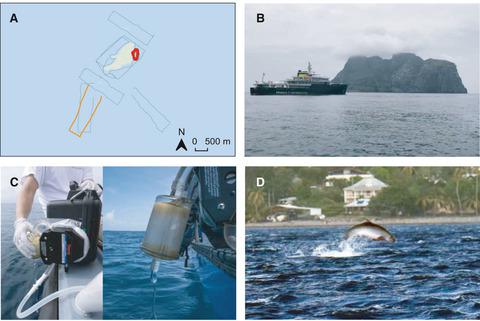当前位置:
X-MOL 学术
›
Ecol. Evol.
›
论文详情
Our official English website, www.x-mol.net, welcomes your
feedback! (Note: you will need to create a separate account there.)
Detection of the elusive Dwarf sperm whale (Kogia sima) using environmental DNA at Malpelo island (Eastern Pacific, Colombia)
Ecology and Evolution ( IF 2.3 ) Pub Date : 2021-03-04 , DOI: 10.1002/ece3.7057 Jean-Baptiste Juhel 1 , Virginie Marques 1, 2 , Andrea Polanco Fernández 3 , Giomar H Borrero-Pérez 3 , Maria Mutis Martinezguerra 3 , Alice Valentini 4 , Tony Dejean 4 , Stéphanie Manel 2 , Nicolas Loiseau 1 , Laure Velez 1 , Régis Hocdé 1 , Tom B Letessier 5 , Eilísh Richards 6 , Florine Hadjadj 1 , Sandra Bessudo 7 , Felipe Ladino 7 , Camille Albouy 8 , David Mouillot 1 , Loïc Pellissier 6, 9
中文翻译:

在马尔佩洛岛(哥伦比亚东太平洋)利用环境 DNA 检测难以捉摸的矮抹香鲸 (Kogia sima)
更新日期:2021-04-04
Ecology and Evolution ( IF 2.3 ) Pub Date : 2021-03-04 , DOI: 10.1002/ece3.7057 Jean-Baptiste Juhel 1 , Virginie Marques 1, 2 , Andrea Polanco Fernández 3 , Giomar H Borrero-Pérez 3 , Maria Mutis Martinezguerra 3 , Alice Valentini 4 , Tony Dejean 4 , Stéphanie Manel 2 , Nicolas Loiseau 1 , Laure Velez 1 , Régis Hocdé 1 , Tom B Letessier 5 , Eilísh Richards 6 , Florine Hadjadj 1 , Sandra Bessudo 7 , Felipe Ladino 7 , Camille Albouy 8 , David Mouillot 1 , Loïc Pellissier 6, 9
Affiliation

|
- Monitoring large marine mammals is challenging due to their low abundances in general, an ability to move over large distances and wide geographical range sizes.
- The distribution of the pygmy (Kogia breviceps) and dwarf (Kogia sima) sperm whales is informed by relatively rare sightings, which does not permit accurate estimates of their distribution ranges. Hence, their conservation status has long remained Data Deficient (DD) in the Red list of the International Union for Conservation of Nature (IUCN), which prevent appropriate conservation measures.
- Environmental DNA (eDNA) metabarcoding uses DNA traces left by organisms in their environments to detect the presence of targeted taxon, and is here proved to be useful to increase our knowledge on the distribution of rare but emblematic megafauna.
- Retrieving eDNA from filtered surface water provides the first detection of the Dwarf sperm whale (Kogia sima) around the remote Malpelo island (Colombia).
- Environmental DNA collected during oceanic missions can generate better knowledge on rare but emblematic animals even in regions that are generally well sampled for other taxa.
中文翻译:

在马尔佩洛岛(哥伦比亚东太平洋)利用环境 DNA 检测难以捉摸的矮抹香鲸 (Kogia sima)
监测大型海洋哺乳动物具有挑战性,因为它们的丰度普遍较低,且能够长距离移动且地理范围广泛。
侏儒抹香鲸( Kogia breviceps )和侏儒抹香鲸( Kogia sima )的分布是通过相对罕见的目击事件得知的,因此无法准确估计它们的分布范围。因此,它们的保护状态长期处于国际自然保护联盟(IUCN)红色名录中的数据缺乏(DD)状态,阻碍了适当的保护措施。
环境 DNA (eDNA) 元条形码利用生物体在其环境中留下的 DNA 痕迹来检测目标分类单元的存在,并被证明有助于增加我们对稀有但具有象征意义的巨型动物分布的了解。
从过滤后的地表水中提取 eDNA 首次发现了偏远的马尔佩洛岛(哥伦比亚)周围的矮抹香鲸( Kogia sima )。
在海洋任务期间收集的环境 DNA 可以更好地了解稀有但具有象征意义的动物,即使是在通常对其他类群进行良好采样的地区也是如此。











































 京公网安备 11010802027423号
京公网安备 11010802027423号